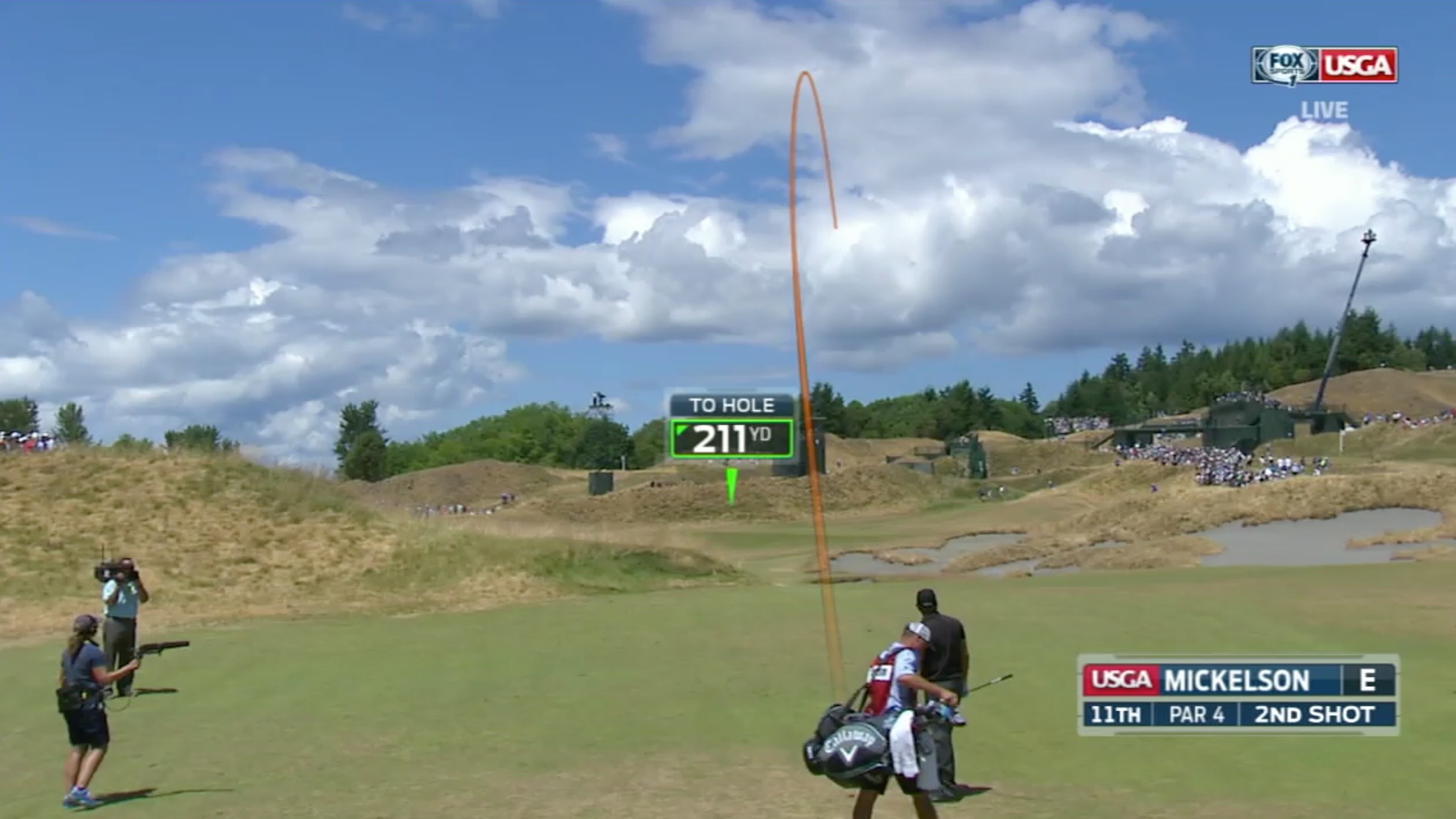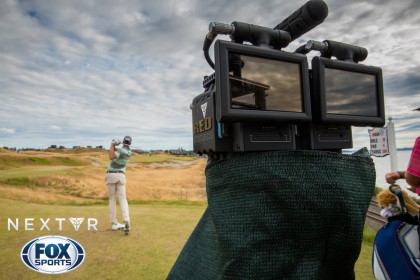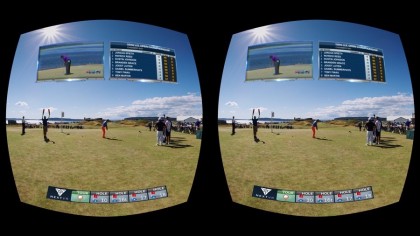This year's US Open broadcast taps into tech like never before
VR, 4K and more tracking tech than you ever thought you needed

The 116th US Open golf tournament tees off June 16, and when it does broadcast partner FOX Sports will tap into a host of innovations to bring viewers closer to the high-stakes action than ever before.
These enhanced viewing features include multi-camera virtual reality looks at four holes, microphones in all 18, aerial drone coverage, mobile radio-frequency (RF) shot tracking, 4K coverage of three holes and advanced green shading to show off the renowned slopes of the Oakmont Country Club.
The innovations coming to the 2016 broadcast are the result of years' of talking and tinkering, stretching back to 2013 when the network first struck a deal with the United States Golf Association (USGA), Zac Fields, Senior Vice President, Graphic Tech/Integration at FOX Sports, tells me. The idea then, as it is now: give viewers something they've never seen before in golf, using the latest technologies to make it happen.
"One of the things we really wanted to achieve was, how do we create new depth and allow the viewer to see more on TV," Fields says. "There's so many things going on in the field of play that don't really translate to the TV viewer. How far away the golfer is from the hole, things the golfer can't see. We asked, 'How can we show more?'"
FOX Sports was the first to use a licensed drone for a broadcast when it sent one above the Franklin Templeton Shootout in 2014, Fields says. The concept for the rangefinder first sprang up in late 2013 with the aim of delivering more depth to viewers.
"We wanted to unflatten the experience," Fields explains. "On TV, it may look like it's 200 yards, but it may only be a short wedge for the golfer."
Last year, the production crew relied on a shot rangefinder that was "really large unit" and required three people to move as it followed groups around the green. This year, the tech has shrunk to a small handheld configuration that works via RF. Three will be utilized throughout the broadcast, able to roam anywhere on the course to show the trace of the ball at any hole. Fields calls it a "huge jump in technology from where we left off last year."
Sign up for breaking news, reviews, opinion, top tech deals, and more.
Fields seems particularly keen on the shaded green feature, which displays the undulations and slopes of the green to reveal which way the ball will break. This year, FOX Sports is adding a grid with animations to better highlight this course's slopes.
"At Oakmont, the slopes are more prevalent than the undulations, so with the shaded green, we needed to enhance that," Fields says. "We've shown it in internally, and the response has been positive. We've heard you can look at it and right away know the message we are trying to send, which is so important for TV."

Fields says that while FOX Sports has a certain tech tool set for its broadcasts, the production team still has to take into consideration what will work for each particular course, and even hole-to-hole.
"One tool we have is a picture-in-picture showing the trace of the ball," he says. "There's the shot behind the golfer, but on the side of the green is an overview of the ball being tracked. It's like what you'd see in a video game. It gives some perspective for certain holes. We utilize a Trackman radar to show how far the ball will carry, how fast it will carry, all those things."
Virtual drivers
FOX Sports isn't letting the exploding popularity of virtual reality pass it by. Fields says the network has been "tinkering a lot in virtual reality," picking up valuable learnings along the way.
"With virtual reality, we've found that it's important that we give users some sort of interaction," he says. "This year, we'll have four different cameras on four holes plus two roving cameras. We're allowing viewers to navigate hole to hole, they can see a leader board and switch to a different cameras. It's not just you sitting there, waiting for some action to happen."
Michael Davies, FOX Sports' Senior Vice President of Field Operations, notes it's exceptionally difficult to shoot golf in VR because of the sport's "large geographical footprint." Rather than attempt to shoot the entire tournament in VR, FOX Sports selected Holes 9, 17 and 18 as well as neighboring Holes 10 and 12 to play host to VR.
"One of the things you miss a little bit on TV is that by viewing on a 2D medium, you miss the topography and some of the fairway and green construction of the course," Davies says. "With VR, you feel like you're standing next to one of the top golfers as they tee off, or you're in the gallery and can see why a ball rolls a certain way."

In addition to live golf, short-form snippets will feature on-air talent talking about the course and tournament for those strapping on headsets. All you need is a Samsung Gear VR and the NextVR app to tune in.
The network may be embracing VR, but Fields says it's still in the feeling-out stage with the technology.
"It's too early to say whether every event we do some sort of VR," he says when asked if he thinks the tech will become part of every broadcast. "Certain sports lend themselves to VR better than others. As it evolves, we'll figure out what works best for the viewer and take into consideration how we can get it out to viewers. How many viewers can access it? How do we go where the viewers go?"
For his part, Davies thinks VR has the potential to play an integral role in sports broadcasts, though, right now, it's more about experimenting and helping viewers adapt to the technology.
"I've know enough about TV tech not to speak in absolutes. Just look at 3D TV," he says. "There's not really a lot of viewers for VR - though we welcome all to come - however it's more of a learning experience for us and for the viewer. It's kind of like a development project we're doing with the viewer, and we're really relearning the storytelling medium to figure out what works."
Fore! K
FOX Sports will also deliver 4K coverage on DirecTV of three featured holes (3, 13 and 17). It's the first foray for the network into live, original 4K content, and one both Fields and Davies are excited to show off.
"Oakmont and the holes we're going to do [4K] on are going to look fantastic," Davies says.
If it seems like a whole host of technology is being used in the US Open broadcast, that's because it is. Davies describes tentpole events like this, where the production team is on the ground for two weeks, as the "mobile laboratory that we are able to roll out and work on against the backdrop of a really iconic event."
"It's stuff literally nobody has seen before," Davies says. "A lot of it's improvements over what we did last year, but we're hoping some of the things we do - like the VR and 4K - are going to turn some heads."

Innovation or intrusion?
As with most live-action broadcasts, there exists in golf that fine line between delivering up-close, visceral views to the audience, and crossing the line into interrupting the course of play. Golfers especially rely on mental focus and routine to stay on top of their game - how does FOX Sports balance its desire to show viewers more without being a nuisance to the athletes?
"It's an important question," Fields says. "I'd say we've improved this year especially with the rangefinder. Last year, it was in essence a moveable camera right. We had to move it and we were close to the players, which is a little different than what they're used to.
"We got some guidelines from the USGA and stayed out of the way, but it is different for them, so we have to be careful about that. The RF tracer helps. With the hole mics, we've made them so small, they're barely visible. In golf in general, there's the camera men, the audio technicians, so a lot of people around, but you also have to give players the proper space that's needed."
Audio is almost as important to the FOX Sports broadcast as video because it brings the audience into the action, Fields says.
"The viewer can never be close enough to the sport, and audio is a huge part of that," he says. "It lets you hear Jason Day and Dustin Johnson talking to each other on the 72nd hole, or [Jordan] Spieth and his caddy."
The sheer scale of the US Open and its production is worthy of adulation. Fields says he's worked Super Bowls and the Daytona 500, but his first US Open was "the largest event I'd ever worked on and much bigger than I could ever imagine."
Over 155 cameras will be put to work over the weekend, 36 miles of fiber optic cable laid down, and 61,000-plus manhours logged over the course of two weeks to prepare of the broadcast.
As technology finds its way into more sports coverage, FOX Sports is keenly aware of not going overboard with tech in its broadcasts, showing off the latest and greatest just because it can.
"One of the things we have to balance is not using technology for technology's sake, and using technology to enhance the broadcast," Fields says. "Leading up to last year, there was a lot of buzz about what FOX was bringing to golf. What we're really proud of is that we didn't get in the way of the event. Our production team does a great job of that: Use the tools to tell stories, and to show you things you wouldn't see otherwise. Have a purpose. Don't just do it to get it on the air."
- Oculus Rift review: is it really the future of VR?

Michelle was previously a news editor at TechRadar, leading consumer tech news and reviews. Michelle is now a Content Strategist at Facebook. A versatile, highly effective content writer and skilled editor with a keen eye for detail, Michelle is a collaborative problem solver and covered everything from smartwatches and microprocessors to VR and self-driving cars.